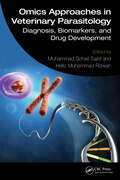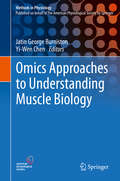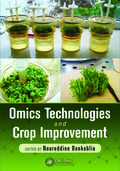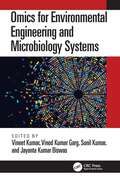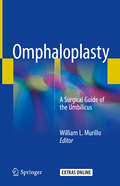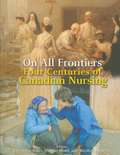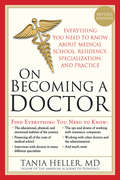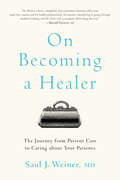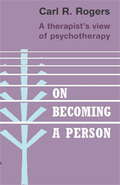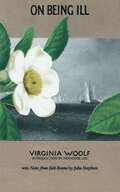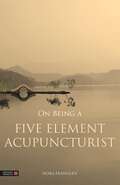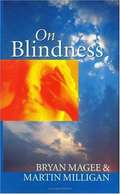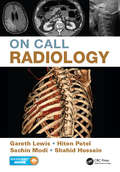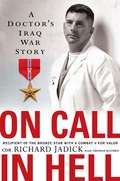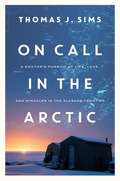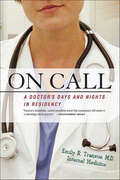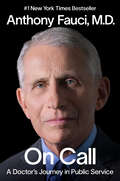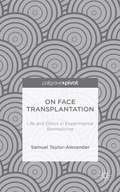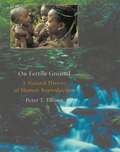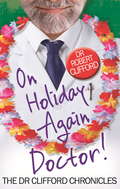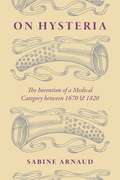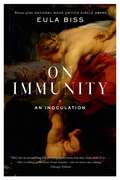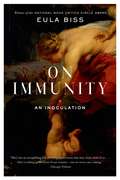- Table View
- List View
Omics Approaches in Veterinary Parasitology: Diagnosis, Biomarkers, and Drug Development
by Muhammad Sohail Sajid and Hafiz Muhammad RizwanOmics Approaches in Veterinary Parasitology: Diagnosis, Biomarkers, and Drug Development explores applications of omics approaches for diagnosis, biomarker discovery, and drug development against parasites of veterinary importance. It presents the fundamental principles of parasite biology and their complex physiological processes. The chapters review key aspects such as parasite life cycles, host-parasite interactions, and the molecular mechanisms that underlie parasitic diseases. The subsequent chapters delve into the principles and applications of genomics, transcriptomics, proteomics, and metabolomics in understanding parasites at a molecular level. The use of next-generation sequencing, PCR-based assays, and metagenomics in identifying and characterizing parasites for accurate and efficient diagnosis are also covered in detail. Toward the end, the book focuses on target identification, drug repurposing, and the optimization of drug efficacy while minimizing drug resistance using omics data. The book is useful for researchers, students, and professionals in the field of veterinary parasitology.
Omics Approaches to Understanding Muscle Biology (Methods in Physiology)
by Jatin George Burniston Yi-Wen ChenThis book is a collection of principles and current practices in omics research, applied to skeletal muscle physiology and disorders. The various sections are categorized according to the level of biological organization, namely, genomics (DNA), transcriptomics (RNA), proteomics (protein), and metabolomics (metabolite). With skeletal muscle as the unifying theme, and featuring contributions from leading experts in this traditional field of research, it highlights the importance of skeletal muscle tissue in human development, health and successful ageing. It also discusses other fascinating topics like developmental biology, muscular dystrophies, exercise, insulin resistance and atrophy due to disuse, ageing or other muscle diseases, conveying the vast opportunities for generating new hypotheses as well as testing existing hypotheses by combining high-throughput techniques with proper experiment designs, bioinformatics and statistical analyses. Presenting the latest research techniques, this book is a valuable resource for the physiology community, particularly researchers and grad students who want to explore the new opportunities for omics technologies in basic physiology research.
Omics Technologies and Crop Improvement
by Noureddine BenkebliaIncreased world population, decreased water supply, and climate change all put stresses on the global food supply. An exploration of the challenges and possible solutions to improve yields of the main crops, such as cereals, roots, tubers, and grasses, Omics Technologies and Crop Improvement reviews data on food sciences and omics. The book covers
Omics for Environmental Engineering and Microbiology Systems
by Vineet KumarBioremediation using microbes is a sustainable technology for biodegradation of target compounds, and an omics approach gives more clarity on these microbial communities. This book provides insights into the complex behavior of microbial communities and identifies enzymes/metabolites and their degradation pathways. It describes the application of microbes and their derivatives for the bioremediation of potentially toxic and novel compounds. It highlights the existing technologies along with industrial practices and real-life case studies. Features: Includes recent research and development in the areas of omics and microbial bioremediation. Covers the broad environmental pollution control approaches such as metagenomics, metabolomics, fluxomics, bioremediation, and biodegradation of industrial wastes. Reviews metagenomics and waste management, and recycling for environmental cleanup. Describes the metagenomic methodologies and best practices, from sample collection to data analysis for taxonomies. Explores various microbial degradation pathways and detoxification mechanisms for organic and inorganic contaminants of wastewater with their gene expression. This book is aimed at graduate students and researchers in environmental engineering, soil remediation, hazardous waste management, environmental modeling, and wastewater treatment.
Omphaloplasty: A Surgical Guide Of The Umbilicus
by William L. MurilloThis book offers an essential guide to surgical approaches to the umbilicus. The navel is the only natural scar in the body, accepted for all human beings all over the world. Its absence or distortions can have negative psychological impacts, as it normally lends beauty and harmony to the otherwise unattractive abdomen. The aesthetic importance of the navel justifies the increasing amount of individuals undergoing abdominoplasty and omphaloplasty. However, these surgeries may lead to a series of complications or unintended aesthetic outcomes. Indeed, the postsurgical final aspect of the umbilicus is the main stigma and primary source of problems and complaints following abdominoplasty. In this book readers will find a complete surgical guide to the most important surgical approaches and strategies related to the navel, helping them to deliver a high standard of quality and patient-tailored surgical and aesthetic outcomes. Written by a renowned plastic surgeons with more than 20 years of experience, Omphaloplasty - A Surgical Guide of the Umbilicus offers readers an overview of general and innovative surgical techniques for the umbilicus, helping them to make the best choice when performing abdominoplasties.
On All Frontiers: Four Centuries of Canadian Nursing
by Christina Bates, Dianne Dodd & Nicole RousseauNursing has a long and varied history in Canada. Since the founding of the first hospital by the Augustine nuns in 1637, nurses have contributed greatly to Canadians' quality of life.On All Frontiers is a comprehensive history of Canadian nursing. Editors Christina Bates, Dianne Dodd, and Nicole Rousseau have brought together a vast body of research into one volume. Authored by leading experts, the chapters and vignettes form an overview of the history of Canadian nursing to date.From the midwives of early Canada to urban public health nurses, from remote outposts to the battlefields of Europe, On All Frontiers documents the hardships, challenges, and achievements of Canadian nurses. Richly illustrated with archival photographs, it will prove essential to scholars of Canadian health care history.
On Becoming a Doctor
by Tania HellerEverything They Don't Tell You, Everything You Need to KnowBecoming a doctor is so much more than acing your MCATs, living through med school, then getting the perfect residency. It is a career that demands long hours on little to no sleep, constant continuing education, and a tough decision about which of the many types of medicine you want to practice. But with the right guide, you can make the right choices each step of the way. On Becoming a Doctorcalmly and thoroughly walks you through each academic, physical, and emotional step you'll take on your way to a successful career in medicine, and it includes interviews with many different specialists to help you choose a medical path. This Essential Insider Advice Will Show You:Financing all of the costs of medical schoolThe ups and downs of working with insurance companiesPerspectives on a variety of medical fieldsThe educational, physical, and emotional realities of the journeyInterviews with doctors in many different specialtiesWorking with other doctors and the administration On Becoming a Doctorcovers everything you need to know about medical school, residency, specialization, and practice.
On Becoming a Healer: The Journey from Patient Care to Caring about Your Patients
by Saul J. WeinerAn invaluable guide to becoming a competent and compassionate physician.Medical students and physicians-in-training embark on a long journey that, although steeped in scientific learning and technical skill building, includes little guidance on the emotional and interpersonal dimensions of becoming a healer. Written for anyone in the health care community who hopes to grow emotionally and cognitively in the way they interact with patients, On Becoming a Healer explains how to foster doctor-patient relationships that are mutually nourishing. Dr. Saul J. Weiner, a physician-educator, argues that joy in medicine requires more than idealistic aspirations—it demands a capacity to see past the "otherness" that separates the well from the sick, the professional in a white coat from the disheveled patient in a hospital gown. Weiner scrutinizes the medical school indoctrination process and explains how it molds the physician's mindset into that of a task completer rather than a thoughtful professional. Taking a personal approach, Weiner describes his own journey to becoming an internist and pediatrician while offering concrete advice on how to take stock of your current development as a physician, how to openly and fully engage with patients, and how to establish clear boundaries that help defuse emotionally charged situations. Readers will learn how to counter judgmentalism, how to make medical decisions that take into account the whole patient, and how to incorporate the organizing principle of healing into their practice. Each chapter ends with questions for reflection and discussion to help personalize the lessons for individual learners.
On Becoming a Person: Person-centered Teaching, Psychology, Philosophy, And Dialogues With Carl R. Rogers And Harold Lyon
by Carl RogersIn this book, one of America's most distinguished psychologists describes his experiences in helping people to discover the path to personal growth through an understanding of their own limitations and potential. What is personal growth? Under what conditions is it possible? How can one person help another? What is creativity, and how can it be fostered? These are some of the issues raised, which challenge many concepts of traditional psychology.Contemporary psychology derives largely from the experimental laboratory, or from Freudian theory. It is preoccupied with minute aspects of animal and human behaviour, or with the mentally ill. But there are rebels, of whom the author counts himself as one, along with Gordon Allport, Abraham Maslow and Rollo May, who feel that psychology and psychiatry should be aiming higher, and be more concerned with growth and potentiality in man. The interest of such a psychology is in the production of harmoniously mature individuals, given that we all have qualities and possibilities infinitely capable of development. Successful development makes us more flexible in relationships, more creative, and less open to suggestion and control.This book, philosophical and provocative, summarizes Dr Rogers' experience. Non-technical in its language, it is not only for psychologists and psychiatrists, but for teachers and counsellors, religious and social workers, labour-management specialists and anyone interested in 'becoming'.
On Being Ill: with Notes from Sick Rooms by Julia Stephen
by Virginia WoolfVirginia Woolf&’s daring essay on how illness transforms our perception, plus an essay by Woolf&’s mother from the caregiver&’s perspective: &“Revelatory.&” —Booklist This new publication of &“On Being Ill&” with &“Notes from Sick Rooms&” presents Virginia Woolf and her mother, Julia Stephen, in textual conversation for the first time in literary history. In the poignant and humorous essay &“On Being Ill,&” Woolf observes that though illness is part of every human being&’s experience, it is not celebrated as a subject of great literature in the way that love and war are embraced by writers and readers. We must, Woolf says, invent a new language to describe pain. Illness, she observes, enhances our perceptions and reduces self-consciousness; it is &“the great confessional.&” Woolf discusses the taboos associated with illness, and she explores how it changes our relationship to the world around us. &“Notes from Sick Rooms,&” meanwhile, addresses illness from the caregiver&’s perspective. With clarity, humor, and pathos, Julia Stephen offers concrete information that remains useful to nurses and caregivers today. This edition also includes an introduction to &“Notes from Sick Rooms&” by Mark Hussey, founding editor of Woolf Studies Annual, and a poignant afterword by Rita Charon, MD, founder of the field of Narrative Medicine. In addition, Hermione Lee&’s brilliant introduction to &“On Being Ill&” offers a superb overview of Woolf&’s life and writing. &“Woolf&’s inquiry into illness and its impact on the mind is paired with her mother&’s observations about caring for the body. Julia Stephen . . . had no professional training but took to heart Florence Nightingale&’s precept that every woman is a nurse and emulated Nightingale&’s best-selling Notes on Nursing with her own &“Notes from Sick Rooms.&” In this long-overlooked, precise, and piquant little manual, Stephen is compassionate and ironic, observing that everyone deserves to be tenderly nursed while addressing the small evil of crumbs in bed. This unprecedented literary reunion of mother and daughter is stunning on many fronts, but physician and literary scholar Rita Charon focuses on the essentials in her astute afterword, writing that Woolf&’s perspective as a patient and Stephen&’s as a nurse together illuminate the goal of care—to listen, to recognize, to imagine, to honor.&” —Booklist &“Woolf and Stephen will certainly change the way readers think of illness.&” —Publishers Weekly
On Being a Five Element Acupuncturist
by Nora FranglenWhat does it mean to 'be' an acupuncturist? How does a highly experienced acupuncturist view her practice, her patients, and the world in general? Based on her widely-read blog about the wholeness of life as a Five Element practitioner, Nora Franglen's breadth of interest shows how the curiosity and life experiences of the individual lie at the heart of what makes a true acupuncturist, over and beyond the necessary knowledge and expertise in the technicalities of practice. From her penchant for coffee shops to reflections on challenges she has experienced in the clinic, Nora illustrates how the Five Elements influence, illuminate and, ultimately, enrich all aspects of her life, and vice versa. With reflections gathered from over several years of posting linked by Nora's commentary, this diary is truly enlightening reading for anyone interested in the inner workings of a practitioner at one with her craft.
On Blindness: Letters Between Bryan Magee and Martin Milligan
by Bryan Magee Martin MilliganOn Blindness asks fascinating questions about the world of the blind, including: How can the born-blind know they are blind? Can a blind person play a game of snooker? How does a blind person dream? On Blindness open the eyes of the sighted to the world as experienced by the blind, offering a unique opportunity to explore the challenges, frustrations,joys--and extraordinary insights--experienced in discovering the world without sight. What difference does sight--or its absence--make to our ideas about the world? What begins as a philosophical exchange between the noted philosopher and broadcaster Bryan Magee and the late Martin Milligan, activist and philosopher--blind almost from birth-- develops into an intense and personal discussion of the implications of blindness. The debate is vigorous and often heated; sometimes contentious, it is always stimulating. They discuss the whole spectrum of blind-experience, including the born-blind, those who lose their sight, and those forced to come to terms with the shock of gaining a sight they had never possessed. This extraordinary book casts new light on one of the most fundamental aspects of human experience. It will make fascinating reading for anyone interested insight and blindness from a personal, practical, or philosophical point of view.
On Call Radiology
by Gareth Lewis Shahid Hussain Sachin Modi Hiten PatelOn-Call Radiology presents case discussions on the most common and important clinical emergencies and their corresponding imaging findings encountered on-call. Cases are divided into thoracic, gastrointestinal and genitourinary, neurological and non-traumatic spinal, paediatric, trauma, interventional and vascular imaging. Iatrogenic complications are also discussed. <P><P>Each case is presented as a realistic clinical scenario and includes a clinical history and request for imaging. Multi-modality imaging examples and a case discussion on the diagnosis and basic management, with emphasis on important radiological findings, are also presented. <P><P>This book combines a case-based discussion format with practical advice on imaging decision making in the acute setting. It also offers guidance on radiology report writing and techniques, with a focus on relevant positive and negative findings to pass on to referring clinicians. On-call Radiology offers invaluable knowledge and practical tips for any on-call radiologist.
On Call in Hell: A Doctor's Iraq War Story
by Thomas Hayden Richard JadickThe author tells his experiences of working in Fallujah at one of the bloodiest battles in Iraq.
On Call in the Arctic: A Doctor's Pursuit Of Life, Love, And Miracles In The Alaskan Frontier
by Thomas J. SimsAn extraordinary memoir recounting the adventures of a young doctor stationed in the Alaskan bush. The fish-out-of-water stories of Northern Exposure and Doc Martin meet the rough-and-rugged setting of The Discovery Channel’s Alaskan Bush People in Thomas J. Sims’s On Call in the Arctic, where the author relates his incredible experience saving lives in one of the most remote outposts in North America. Imagine a young doctor, trained in the latest medical knowledge and state-of-the-art equipment, suddenly transported back to one of the world’s most isolated and unforgiving environments—Nome, Alaska. Dr. Sims’ plans to become a pediatric surgeon drastically changed when, on the eve of being drafted into the Army to serve as a M.A.S.H. surgeon in Vietnam, he was offered a commission in the U.S. Public Health for assignment in Anchorage, Alaska. In Anchorage, Dr. Sims was scheduled to act as Chief of Pediatrics at the Alaska Native Medical Center. Life changed, along with his military orders, when he learned he was being transferred from Anchorage to work as the only physician in Nome. There, he would have the awesome responsibility of rendering medical care under archaic conditions to the population of this frontier town plus thirteen Eskimo villages in the surrounding Norton Sound area. And he would do it alone with little help and support. All the while, he was pegged as both an “outsider” and an employee of the much-derided federal government. In order to do his job, Dr. Sims had to overcome racism, cultural prejudices, and hostility from those who would like to see him sent packing. On Call in the Arctic reveals the thrills and the terrors of frontier medicine, where Dr. Sims must rely upon his instincts, improvise, and persevere against all odds in order to help his patients on the icy shores of the Bering Sea.
On Call: A Doctor's Days and Nights in Residency
by Emily R. TransueOn Call begins with a newly-minted doctor checking in for her first day of residency--wearing the long white coat of an MD and being called "Doctor" for the first time. Having studied at Yale and Dartmouth, Dr. Emily Transue arrives in Seattle to start her internship in Internal Medicine just after graduating from medical school. This series of loosely interconnected scenes from the author's medical training concludes her residency three years later.During her first week as a student on the medical wards, Dr. Transue watched someone come into the emergency room in cardiac arrest and die. Nothing like this had ever happened to her before-it was a long way from books and labs. So she began to record her experiences as she gained confidence putting her book knowledge to work.The stories focus on the patients Dr. Transue encountered in the hospital, ER and clinic; some are funny and others tragic. They range in scope from brief interactions in the clinic to prolonged relationships during hospitalization. There is a man newly diagnosed with lung cancer who is lyrical about his life on a sunny island far away, and a woman, just released from a breathing machine after nearly dying, who sits up and demands a cup of coffee.Though the book has a great deal of medical content, the focus is more on the stories of the patients' lives and illnesses and the relationships that developed between the patients and the author, and the way both parties grew in the course of these experiences.Along the way, the book describes the life of a resident physician and reflects on the way the medical system treats both its patients and doctors. On Call provides a window into the experience of patients at critical junctures in life and into the author's own experience as a new member of the medical profession.
On Call: A Doctor's Journey in Public Service
by Anthony FauciThe memoir by the doctor who became a beacon of hope for millions through the COVID pandemic, and whose six-decade career in high-level public service put him in the room with seven presidents <P><P> Anthony Fauci is arguably the most famous – and most revered – doctor in the world today. His role guiding America sanely and calmly through Covid (and through the torrents of Trump) earned him the trust of millions during one of the most terrifying periods in modern American history, but this was only the most recent of the global epidemics in which Dr. Fauci played a major role. His crucial role in researching HIV and bringing AIDS into sympathetic public view and his leadership in navigating the Ebola, SARS, West Nile, and anthrax crises, make him truly an American hero. <P><P> His memoir reaches back to his boyhood in Brooklyn, New York, and carries through decades of caring for critically ill patients, navigating the whirlpools of Washington politics, and behind-the-scenes advising and negotiating with seven presidents on key issues from global AIDS relief to infectious disease preparedness at home. ON CALL will be an inspiration for readers who admire and are grateful to him and for those who want to emulate him in public service. He is the embodiment of “speaking truth to power,” with dignity and results. <p> <b>New York Times Bestseller</b>
On Depression: Drugs, Diagnosis, and Despair in the Modern World
by S. Nassir GhaemiLasting happiness comes not from chasing the American dream but from living an authentic life—which includes despair.In a culture obsessed with youth, financial success, and achieving happiness, is it possible to live an authentic, meaningful life? Nassir Ghaemi, director of the Mood Disorder Program at Tufts Medical Center, reflects on our society's current quest for happiness and rejection of any emotion resembling sadness. On Depression asks readers to consider the benefits of despair and the foibles of an unexamined life. Too often depression as disease is mistreated or not treated at all. Ghaemi warns against the "pretenders" who confuse our understanding of depression—both those who deny disease and those who use psychiatric diagnosis "pragmatically" or unscientifically. But experiencing sadness, even depression, can also have benefits. Ghaemi asserts that we can create a "narrative of ourselves such that we know and accept who we are," leading to a deeper, lasting level of contentment and a more satisfying personal and public life. Depression is complex, and we need guides to help us understand it, guides who comprehend it existentially as part of normal human experience and clinically as sometimes needing the right kind of treatment, including medications. Ghaemi discusses these guides in detail, thinkers like Viktor Frankl, Rollo May, Karl Jaspers, and Leston Havens, among others. On Depression combines examples from philosophy and the history of medicine with psychiatric principles informed by the author's clinical experience with people who struggle with mental illness. He has seen great achievements arise from great suffering and feels that understanding depression can provide important insights into happiness.
On Face Transplantation: Life and Ethics in Experimental Biomedicine
by Samuel Taylor-AlexanderDrawing together interview material, medical publications, and first-hand accounts, this book shows that what is being remade in the burgeoning medical field of face transplantation is not only the lives of patients, but also the very ways that state institutions, surgeons, and families make sense of rights, claims for inclusion, and life itself. This sophisticated account traces the work done by medical and bureaucratic elites to make the life threatening operation a clinical reality. Working within the context of increasing ethical scrutiny, their endeavour has resulted in the delineation of the 'ideal patient' of face transplantation: a person whose particular state of health and suffering allows the operation to be performed given current technical constraints. The operation has introduced into the lives of face transplant recipients a profoundly new sense of personhood in which they continue to negotiate questions of how to relate to their new biology and to those around them.
On Fertile Ground: A Natural History of Human Reproduction
by Peter T. EllisonReproduction is among the most basic of human biological functions, both for our distant ancestors and for ourselves, whether we live on the plains of Africa or in North American suburbs. Our reproductive biology unites us as a species, but it has also been an important engine of our evolution. In the way our bodies function today we can see both the imprint of our formative past and implications for our future. It is the infinitely subtle and endlessly dramatic story of human reproduction and its evolutionary context that Peter T. Ellison tells in On Fertile Ground. <P><P>Ranging from the latest achievements of modern fertility clinics to the lives of subsistence farmers in the rain forests of Africa, this book offers both a remarkably broad and a minutely detailed exploration of human reproduction. Ellison, a leading pioneer in the field, combines the perspectives of anthropology, stressing the range and variation of human experience; ecology, sensitive to the two-way interactions between humans and their environments; and evolutionary biology, emphasizing a functional understanding of human reproductive biology and its role in our evolutionary history. <P><P>Whether contrasting female athletes missing their periods and male athletes using anabolic steroids with Polish farm women and hunter-gatherers in Paraguay, or exploring the intricate choreography of an implanting embryo or of a nursing mother and her child, On Fertile Ground advances a rich and deeply satisfying explanation of the mechanisms by which we reproduce and the evolutionary forces behind their design.
On Holiday Again, Doctor?
by Robert CliffordGastro-enteritis in Marrakesh, kidney stones in the Sahara, a wrenched sternum in Faro, bizarre accidents on a peaceful day's angling . . . It all goes to show that - as their patients would firmly agree - doctors shouldn't go on holiday. In On Holiday Again, Doctor? everyone's favourite West Country G.P. beguiles us with more colourful portraits of family and friends, colleagues and patients; improbable - but true - anecdotes of holidays at home and abroad; some serious comment on the medical profession; and an introduction to the gentle art of nearly going somewhere . . .
On Holiday Again, Doctor? (The Dr Clifford Chronicles)
by Dr Robert CliffordGastro-enteritis in Marrakesh, kidney stones in the Sahara, a wrenched sternum in Faro, bizarre accidents on a peaceful day's angling . . . It all goes to show that - as their patients would firmly agree - doctors shouldn't go on holiday.In On Holiday Again, Doctor? everyone's favourite West Country G.P. beguiles us with more colourful portraits of family and friends, colleagues and patients; improbable - but true - anecdotes of holidays at home and abroad; some serious comment on the medical profession; and an introduction to the gentle art of nearly going somewhere . . .
On Hysteria: The Invention of a Medical Category between 1670 and 1820
by Sabine ArnaudThese days, hysteria is known as a discredited diagnosis that was used to group and pathologize a wide range of conditions and behaviors in women. But for a long time, it was seen as a legitimate category of medical problem--and one that, originally, was applied to men as often as to women. In On Hysteria, Sabine Arnaud traces the creation and rise of hysteria, from its invention in the eighteenth century through nineteenth-century therapeutic practice. Hysteria took shape, she shows, as a predominantly aristocratic malady, only beginning to cross class boundaries (and be limited to women) during the French Revolution. Unlike most studies of the role and status of medicine and its categories in this period, On Hysteria focuses not on institutions but on narrative strategies and writing--the ways that texts in a wide range of genres helped to build knowledge through misinterpretation and recontextualized citation. Powerfully interdisciplinary, and offering access to rare historical material for the first time in English, On Hysteria will speak to scholars in a wide range of fields, including the history of science, French studies, and comparative literature.
On Immunity: An Inoculation
by Eula BissOne of New York Times Best 10 Books of 2014. <P><P> Why do we fear vaccines? A provocative examination by Eula Biss, the author of Notes from No Man's Land, winner of the National Book Critics Circle Award<P> Upon becoming a new mother, Eula Biss addresses a chronic condition of fear--fear of the government, the medical establishment, and what is in your child's air, food, mattress, medicine, and vaccines. She finds that you cannot immunize your child, or yourself, from the world.<P> In this bold, fascinating book, Biss investigates the metaphors and myths surrounding our conception of immunity and its implications for the individual and the social body. As she hears more and more fears about vaccines, Biss researches what they mean for her own child, her immediate community, America, and the world, both historically and in the present moment. She extends a conversation with other mothers to meditations on Voltaire's Candide, Bram Stoker's Dracula, Rachel Carson's Silent Spring, Susan Sontag's AIDS and Its Metaphors, and beyond. On Immunity is a moving account of how we are all interconnected--our bodies and our fates.<P> Chosen for Mark Zuckerberg's "A Year of Books"
On Immunity: An Inoculation
by Eula BissA New York Times Best SellerA National Book Critics Circle Award FinalistA New York Times Book Review Top 10 Book of the YearA Facebook "Year of Books" SelectionOne of the Best Books of the Year* National Book Critics Circle Award finalist * The New York Times Book Review (Top 10) * Entertainment Weekly (Top 10) * New York Magazine (Top 10)* Chicago Tribune (Top 10) * Publishers Weekly (Top 10) * Time Out New York (Top 10) * Los Angeles Times * Kirkus * Booklist * NPR's Science Friday * Newsday * Slate * Refinery 29 * And many more...Why do we fear vaccines? A provocative examination by Eula Biss, the author of Notes from No Man's Land, winner of the National Book Critics Circle AwardUpon becoming a new mother, Eula Biss addresses a chronic condition of fear-fear of the government, the medical establishment, and what is in your child's air, food, mattress, medicine, and vaccines. She finds that you cannot immunize your child, or yourself, from the world. In this bold, fascinating book, Biss investigates the metaphors and myths surrounding our conception of immunity and its implications for the individual and the social body. As she hears more and more fears about vaccines, Biss researches what they mean for her own child, her immediate community, America, and the world, both historically and in the present moment. She extends a conversation with other mothers to meditations on Voltaire's Candide, Bram Stoker's Dracula, Rachel Carson's Silent Spring, Susan Sontag's AIDS and Its Metaphors, and beyond. On Immunity is a moving account of how we are all interconnected-our bodies and our fates.
